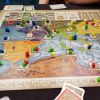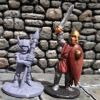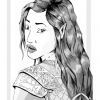Fringe Review: Story Engine from ZDL's blog
Today's review is going to come from the weird side of game publishing. The game is Story Engine and it has a fairly convoluted history that led to its demise and current fate.
History
Our story begins in 1996 with a small indie press outfit called Hubris Games. Hubris published a little game called Maelstrom Storytelling, that had some decent indie success spawning four follow-in products in the process. They also published a free game called Story Bones with the essence of the ideas behind Maelstrom's game system but the setting excised. Then in 1999 they published this game, Story Engine (sub-titled "Universal Rules") and followed that up with a revised edition in 2001.
It is this revised edition which is the subject of this review.
Subsequently Hubris Games vanished from the face of the earth. Promised supplements never showed up, nor did the promised second edition of Maelstrom. Instead, years later, they showed up where all decent dead games go for continued unlife: Precis Intermedia Games (formerly Politically Incorrect Games, a.k.a. PIG). This is where the game languishes now, along with the other Hubris offerings. As is their wont, PIG not only republished the materials they purchased in PDF and POD form, but also published some updates. There is a Story Engine Plus game available from them, for example, which is a cleanup and development of Story Engine, but that is not the subject of this review, largely because they don't accept payment in RMB over WeChat or AliPay…
The Basics
The book is a 136-page perfect-bound, digest-sized book. It has a glossy cover with faux-stone texturing and a golden ring gear, lightly broken, rendered on the cover. The text is minimal on the front and supplies a bit of an overview (and one review blurb) on the back. The paper is matte, cream-coloured, and printed in black ink with a slightly-smallish font that remains readable unless, like me, you have vision problems. (I need my progressives to read it.) The outside strip of each page has a decorative fringe, but the top and bottom are barren. This gives the book a bit of an odd look. Interior art is sparse, but where present ranges from mediocre to actually pretty good.
The one-page table of contents is good and helpful, but also reveals one of the weaknesses of this game. From it you'll notice, for example, that actual rules are 10 pages for Story Bones (they reproduce the free, downloadable game in the published material), then 50 pages for Story Engine itself. With three pages of introduction that leaves you a whole lot of material that is not, well, the game. This includes two illustrative "plug-ins" (we'll be talking more about this later) which can arguably be viewed as part of the rules, adding 30 further pages, and then a whole bunch of filler: 15 pages of fiction, and 30 or so pages covering two adventures. It rounds out with two pages for a character sheet. Notably absent: an index. And it needs one, really, especially given the odd terminology the game presents. (More on that later as well.)
Personally I think only the 50 pages of actual rules hold value for publication. Story Bones should have remained a downloadable resource, and the two plug-ins should have been there as well. (They can't be used meaningfully without the rules so it doesn't matter.) The fiction should have been tossed, and the adventures as well, except again as perhaps downloadable resources. In this 136-page book, really only 50 pages are of any direct use. It's pretty clear that Hubris Games packed everything they could shove inside it just to make the book look more impressive on the book rack in shops.
Story Bones
Story Engine is built up on Story Bones, so we'll quickly go over how the latter works. Characters are first conceived, briefly described (race, gender, age, etc.) then built up from "Descriptors": four adjectives or adjective phrases that defines the character's most salient points. Three Descriptors are more in the positive direction: "clever", "strong as an ox", "cute like picture", etc. The fourth Descriptor is a flaw like "short-sighted" or "dumb like stick" and is referred to as a Quirk. Once descriptors are selected, three Traits are chosen: skills or knacks that help define the capabilities of a character. Great balance. Swordswoman. Tactics. If appropriate to the game setting, you might come up with Special Powers as well.
The game clearly borrows some concepts from earlier adjective-focused games like Theatrix or Over the Edge. (This is not guesswork. They say it in the introduction.) Thus far, then, there's really nothing special. Until you get to the rules for scenes.
This game explicitly tries to remove itself from the wargame mode of RPGs and one of the big ways it does this is by eschewing combat rounds, turns, etc. and instead resolving everything mechanically at the level of entire scenes. There are two kinds of scenes: Open and Rolled. Open scenes are just the talky ones that have no game mechanical component. Rolled scenes, as the name would imply, are resolved with die rolls. Provided advice recommends that most scenes be Open scenes.
Rolled scenes use the die mechanic of the game which is pool-based, but very simple. Every player has a number of dice to roll. What kind of dice? Any kind with an even number of sides! d4, d6, d8, d10, d12, d14, d16, d18, d20 ... whatever floats your boat. This is because when you roll them you only count up the number of dice that came up odd.
The die pool starts with the base die that everybody gets in every scene. You add to this one die for each Descriptor (skipping your Quirk). This is the number of dice you roll in the scene. You can have characters working together (and thus combining their pools), and you can augment the pool by "burning" a Descriptor (including your Quirk). Anytime an action is declared in a Rolled scene, the GM ("narrator") sets a target number/opposing total, Descriptors may get burned for extra dice, and the pool is finally rolled. If the number of odd dice is greater than or equal to the target number, the action succeeds, otherwise it fails. (In an opposed roll, ties are re-rolled.) The difference between the roll and the target number/opposing roll guides how well the action succeeded or how spectacularly it failed. (This also covers injury in combat.)
Once per game session Descriptors (including Quirks) can be "burned". Burned descriptors need a justification line ("I am so QUICK that I can slip past his defences.") and if the GM agrees, one additional die is added to the roll. This Descriptor can no longer be used, however, for future burning. (It still contributes to the die pool.) This means Descriptors are a managed resource, rather like Fate Points in FATE or such.
Any Traits that apply to an action—again with GM approval—replace one die (before rolling) with an "Auto Odd". So if the die pool is 4 dice, and two Traits apply, two dice are treated as if they rolled odd and only two dice are subsequently rolled for chances to add more.
When characters get advantages in scenes (cover, ambushing, ground, etc. in a combat scene, for example) they get dice added to their pool. If they get disadvantages (slippery ground, sky-lighting, etc.) the opposing roll gets an extra die or the target number gets increased. Special items can also have Descriptors which add to the die pool of their users and can even be burned.
Players are awarded Story Points as they play which can be used to buy new Descriptors, Traits, and Special Powers. They can be used in play as well to replenish up to four burnt Descriptors.
And that's Story Bones and that's as deep as we're getting into it because it's not the main point of the review...
Story Engine
This is the meat of the review, although the Story Bones summary sets the ground for much of it. Story Engine is recognizably the same basis as Story Bones but is more detailed and expanded. It unfortunately changes some terminology around for reasons that feel gratuitous to me. Also, where Story Bones allows the use of any (even-numbered) dice, this one strongly recommends the use of d6s because of some mechanical aspects. (This isn't a problem, naturally, given that d6s are cheap like borscht, it's just weird that Story Bones goes out of its way to say you can use any dice only to tell us, a few pages later, that d6s are the right dice. Why not just say d6 to begin with?)
Character creation
There are two ways to create a character: basic and point based. Point based is basically using the experience system (via Story Points, as per Story Bones) to buy up Descriptors, Trait Affinities, and Prime Affinities (to use the new jargon). Basic is more freeform and can be completely free or it can be based on limits like:
- 3 Descriptors
- 1 Quirk
- 3 levels of Trait Affinities
- 1 Prime Affinity
- 1 Story Point
(That is the recommended list for basic characters.)
As with Story Bones, Descriptors are adjectives or adjective phrases that describes a notable facet of the character. A suggested way of coming up with Descriptors is to write a paragraph that describes the character and pick out the words and phrases that make for good Descriptors. Also as with Story Bones there are Quirks that operate in much the same manner.
Unlike with Story Bones, Descriptors are assigned to one of four Aspects. These Aspects are Mind, Matter, Spirit, and Chaos. They describe four kinds of scenes and only Descriptors in the Aspect governing a scene can be applied in that scene. This makes characters more differentiated than they typically are in Story Bones where basically each character, at least at the start, has the same number of dice to throw in resolving each scene.
Mind scenes are about anything mundane that doesn't fall into physical scenes: perception, social interaction, etc. Matter scenes are mundane scenes involving physical actions: fighting, performing difficult manoeuvres, racing, etc. Spirit scenes involve the power of belief, inner strength, and other less-defined "spiritual" matters. Chaos scenes are scenes where luck and stochastic outcomes are the norm.
As with Story Bones too Descriptors can be "burned" once per session to add an extra die to the die pool if there is some way to justify that Descriptor's invocation. They can also be used to invoke a Quick Take in the scene. A Quick Take is a sub-scene whose outcome will have some kind of impact on the main scene. For example if the main scene goal is "fight our way out of the keep", a Quick Take could be used to have one or more characters open the portcullis, something that will definitely have a major impact on the main scene.
(Oh. The term for the target number in a scene's resolution is now called a "Hard Rate". I'm ... not a fan of the new terminology.)
Trait Affinities
What was called "Traits" in Story Bones is now called a Trait Affinity. Trait Affinities come in three levels: Weak Trait, Mild Trait, and Strong Trait granting 1, 2, and 3 Auto Odds to the scene's resolution dice with an upper limit of 3 Auto Odds per character in any given scene, no matter what the value of the traits. When using Trait Affinities you still roll your dice for them (ideally at the same time but with different coloured dice). This is because of a rule for "Rolling Ones" that give you more advantages, so even Auto Odds dice need rolling.
Prime Affinities
Prime Affinities are things that the character is very strongly attuned to or may have a very strong aptitude for. In the basic rules there are two types: Cultural Affinities and Gifts.
All characters start with a Cultural Affinity for their own culture which gives you the basic abilities common to that culture. Thus Mongols would have horse riding, for example, while New Yorkers would have eating crappy pizza and somehow persuading themselves it's ambrosia. The scope and focus of a Cultural Affinity is governed by the scope and focus of the game. Additional Cultural Affinities can be purchased/selected. The "Base Die" of Story Bones stems from the Cultural Affinity and someone operating outside of their cultural milieu will lose that base die in scene resolution to reflect the "fish out of water" aspect.
Gift Affinities are special abilities and are highly setting-specific. GMs (sorry, "Narrators") need to work out Gift Affinities with their players to find something that fits. A bunch of samples are provided both in the main rules and in the two "Plug-Ins" at the back.
Scenes
There is a short procedure for running scenes provided as a reference just before the rules proper begin. It flows like this:
1. Frame the scene.
2. Resolve any Quick Takes.
3. Assign an Aspect.
4. Assign Extra Dice.
5. Add up the Die Pools.
6. Roll the Dice.
7. Determine the Success Range.
This summary is not used for Open scenes which, as in Story Bones, do not get rolled and are based almost purely on interaction. (Occasional quick rolls called Short Tests are used in Open scenes at times for determining simple actions while the scene progresses.) In Rolled scenes, however, of which there are two flavours, Straight Rolls and Bid Scenes, the checklist is followed. Straight Rolls are against a target number called the Hard Rate (*sigh*) while Bid Scenes are against an opposing Die Pool.
This is all pretty much the same as Story Bones with the proviso that d6s should be used because of the Rolling Ones rule. In this system, any 1 result on a die is not only an Odd, it also adds one more die to the die pool. And if that extra die rolls a 1, that adds another die and so on. People familiar with games like Rolemaster will recognize this kind of mechanism and its intent.
Framing
Scenes need to be "framed", answering questions like scope, duration, objective, relationship to other scenes, etc. Cinematic techniques like cutting, cross-cutting, downtime montages, etc. can all be used as part of the framing. Good framing is key to good gaming in this RPG and it will likely take some practice to get used to it because it doesn't have as much assistance in setting it up as later games like Spark or FATE provide.
That being said.
This is, to my knowledge, the absolute first game (well, OK, Maelstrom was, a closely related game) to define and resolve literally everything in terms of scenes and other cinematic/literary concepts instead of the wargame-influenced concepts so oversights like this are understandable. This is the kind of game, however, that needs someone comfortable with both cinematic/literary thinking and improvisation to introduce other players to and I suspect that is part of what led to this game's unlife.
Success and failure
Scenes are resolved as a whole with a single die roll (perhaps augmented by sub-scenes in the form of Quick Takes). This is now a kind of resolution that will make the more wargames-influenced players stare in stark disbelief while people who play games like freeform MUSHes will nod and say "yeah, that makes sense!".
The dice will give you a Success Rate: Complete Success, Basic Success, Partial Success, Partial Failure, Basic Failure, and Complete Failure. Since this is not a round-by-round, attack-by-attack sort of game, once you have the results, you narrate how they play out. The most common question the GM will be asking players after each such roll is "what do you think happened?" with the GM then providing guidance to ensure that the outcome matches the Success Rate.
Thankfully the book provides eight wildly different scene examples to assist in figuring out how to do this. There's not a lot of system support for this new-to-most-players style of gaming, but you can't fault the examples!
The rest
The rest of the rules are small snippets of advice on handling things like modifiers, exchanging injuries for dropped Descriptors and gained Quirks, Story Points (read: experience), props, equipment, settings, etc. The rules come in a strange order that baffled me at first reading, but thankfully occupy only about eight pages so it was easy to figure out on a re-read without being a burden. Several sample characters are provided to show how to use the system.
This is then followed by 15 pages of good, sound, solid advice on how to run the game, including using it with other game systems, using it diceless, and using it for LARP. The advice is good and was groundbreaking for its time, but since then drama-oriented games like FATE and Spark have stepped up the game and this feels a bit anaemic now.
Two "plug-ins" are provided after all this to show how to modify the core rules to suit a specific setting. One of them is "Six Guns & Whiskey", a wild west setting, while the other is the official update to the Maelstrom rules. The first of these is a good example, showing how to integrate setting-specific Trait Affinities and Gift Affinities in a Wild West setting. I think, however, it is a waste of pages in the book given that it would be better as a download (it would be useless without the core rules anyway) and that perhaps it might be better to have a LOT of setting plug-ins to download. (This plug-in is only 8 pages long, and most plug-ins will be in that order of complexity. Indeed just having a place for people to SHARE plug-ins would have been nice!)
The Maelstrom plug-in, however, was a bad idea in my books. It's over 20 pages long and it's absolutely useless to anybody who doesn't have the Maelstrom game. It doesn't show prospective players how to use the system. It is filled with setting-specific gibberish that only makes sense if you've read the main Maelstrom book. It reads like a 20-page advertisement for another game, not like something that is useful.
Here's a better thought: Hubris should have just published a second edition of Maelstrom (as promised!) with the updated rules instead of this cheap gimmick.
The book is then rounded out by mediocre fiction (like every game of the era seems to have demanded!) and two adventures. The first adventure is more Maelstrom advertising (though at least this one they set up so it could be easily used anywhere else as well) while the second shows how to use the game to do a traditional dungeon crawl. That second one may have some utility as an example if nothing else, but the first is, again, to me at any rate, a waste of space.
Paging Goethe! Call for you on the courtesy telephone...
What was Story Engine trying to accomplish? The designer, Christian Aldridge, says he was aiming for divesting RPGs of their wargaming roots with a set of universal rules that used the language and feel of dramatic writing to make a game. And in this he was … call it mostly successful. Filtering for the fact that he was breaking VERY new ground here, I think he did fairly well.
But…
In hindsight, more support was needed in the system itself (like Spark does) for getting that feel, rather than relying on GM talent and expertise almost entirely. Examples are there, as are good explanations of how to accomplish the game's goals, but … shouldn't it be the GAME that accomplishes the game's goals? I cut Mr. Aldridge some slack here, being on the bleeding edge and all that, but it is a negative point weighing down the game.
But even if he had fully succeeded in his goal, was he right to? To this, given my previous gushing over games like FATE and Spark you can already guess that my answer is a fully unqualified, resounding HELL YES!!! I am not a wargamer. I like card games and certain kinds of board games, but wargames (with some exceptions here and there like Battle for Julu B.C. 207) tend to bore me to tears. When I say that a game is very wargamey, that is not a compliment. That is an indictment. Anything that allows gamers to experience life outside of that very narrow wargaming worldview that dominates RPGs to this day is a worthy goal, even if it's imperfect like this attempt.
















The Wall